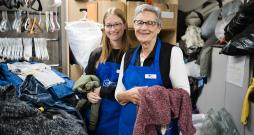Marking 75 years of MCC in Palestine and Israel
Bringing relief, bearing witness
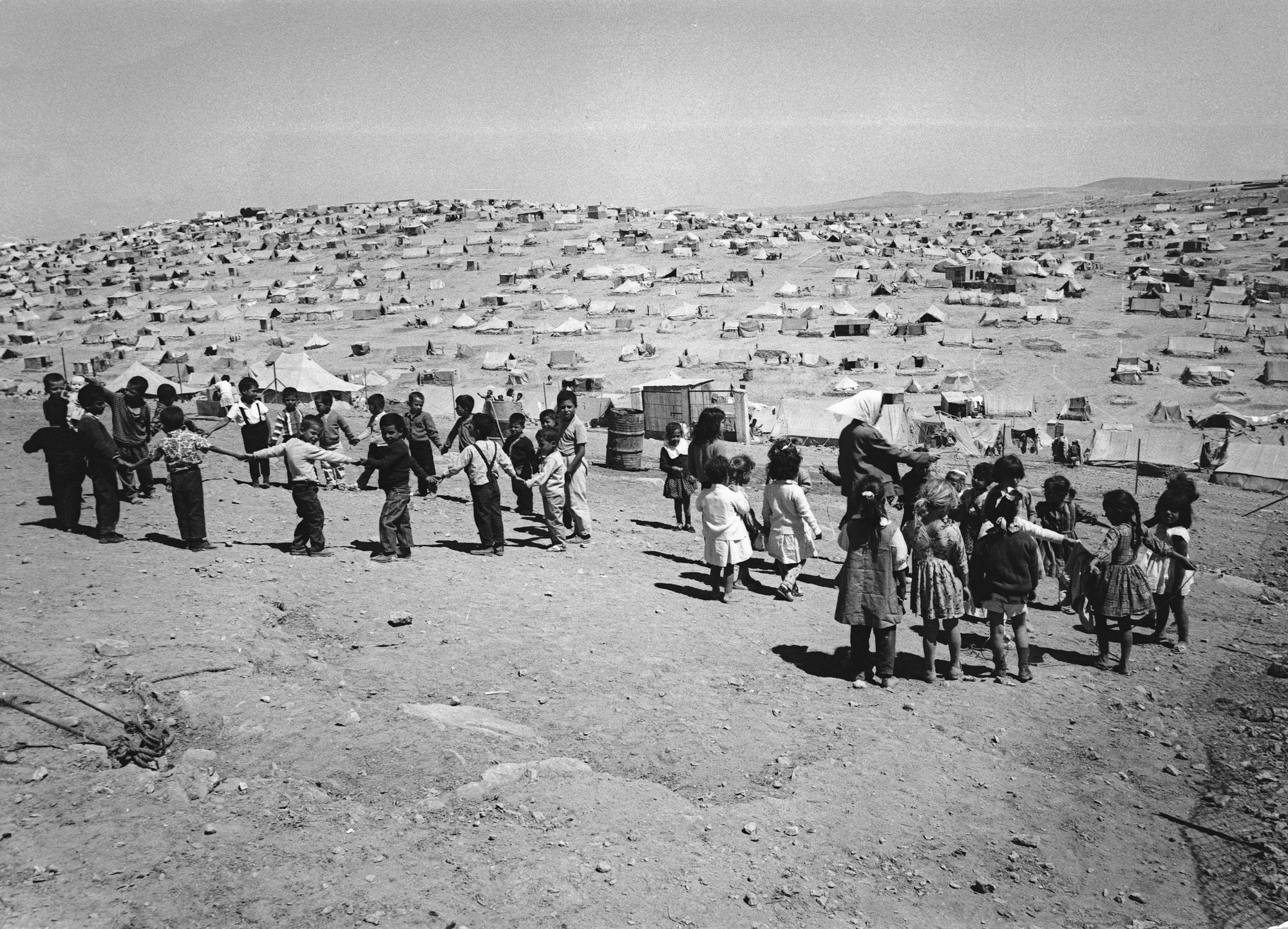
This spring – amid unimaginable destruction in Gaza and as Palestinians mark the 76th anniversary of what is known in Arabic as the Nakba, or Catastrophe, we invite you on a photographic journey through the history of MCC’s work in this region.
Behind these images are countless lives and stories. May we hold this history and the 75 years of MCC’s service in our hearts as we continue to live into MCC’s mission of working for peace and justice. And may we ask how what we see and learn here can shape us to pray, to act, to give, to serve.
(Primary source: Alain Epp Weaver and Sonia K. Weaver, Salt and Sign: Mennonite Central Committee in Palestine 1949-1999)
In the wake of catastrophe
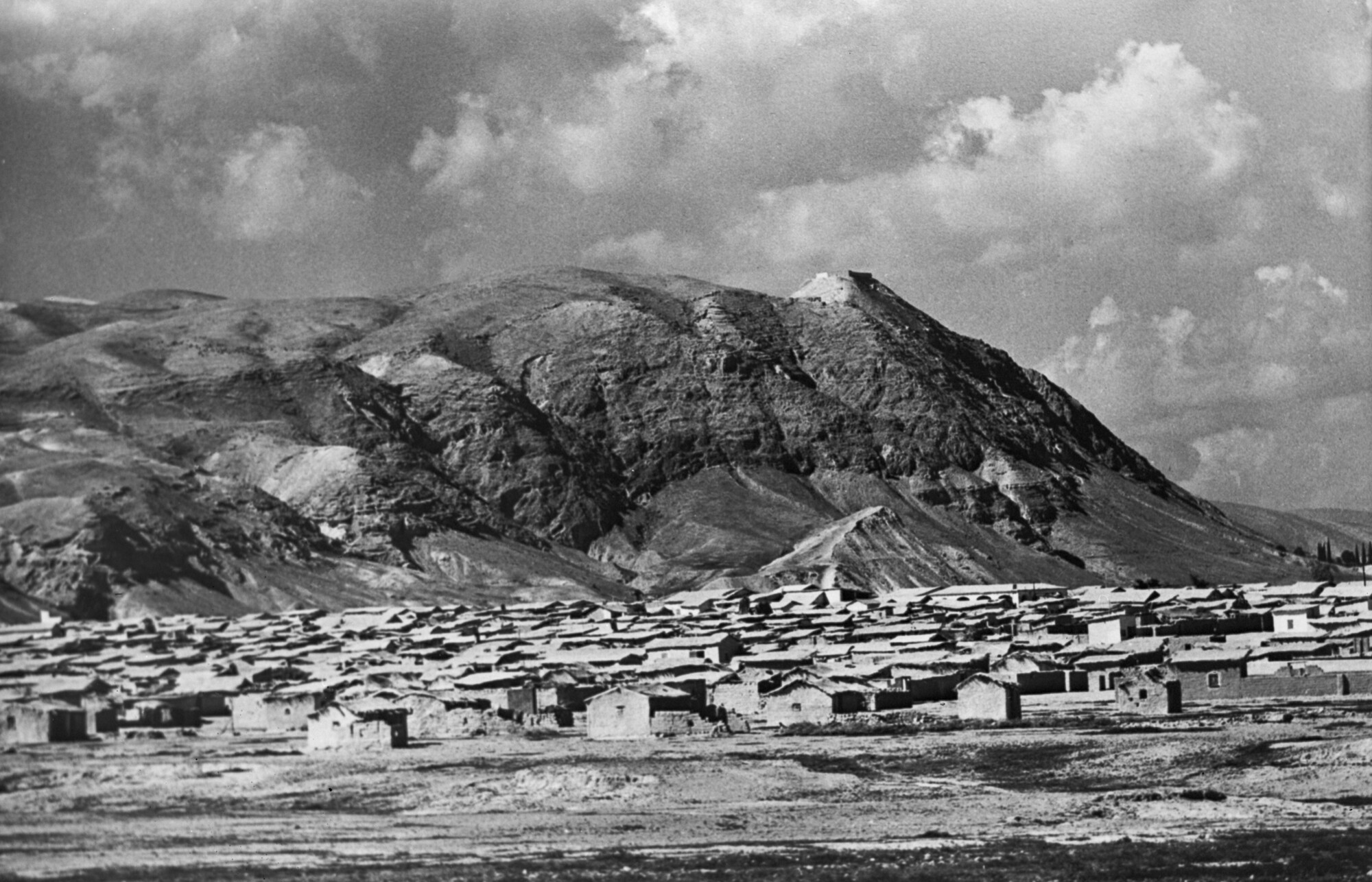
In 1948, around 750,000 Palestinians were driven from or fled their homes in the conflict to establish the State of Israel. The mass dispossession of Palestinians from their lands at this time came to be known among Palestinians as the Nakba, Arabic for catastrophe.
Palestinian society was shattered, with two-thirds of the Palestinian population becoming refugees, forced to flee to the Gaza Strip, the western and eastern banks of the Jordan River, Lebanon and Syria.
The first MCC worker, Titus Lehman, arrived in the Gaza Strip in March 1949 to serve as chief nurse in a field hospital run by the American Friends Service Committee and to explore possibilities for further MCC work.
By 1950, MCC had established a relief unit in Jericho, reaching out to the tens of thousands of people who had settled into camps on the western bank of the Jordan River and, in the process, bearing witness to the devastating effects of mass forced displacement.
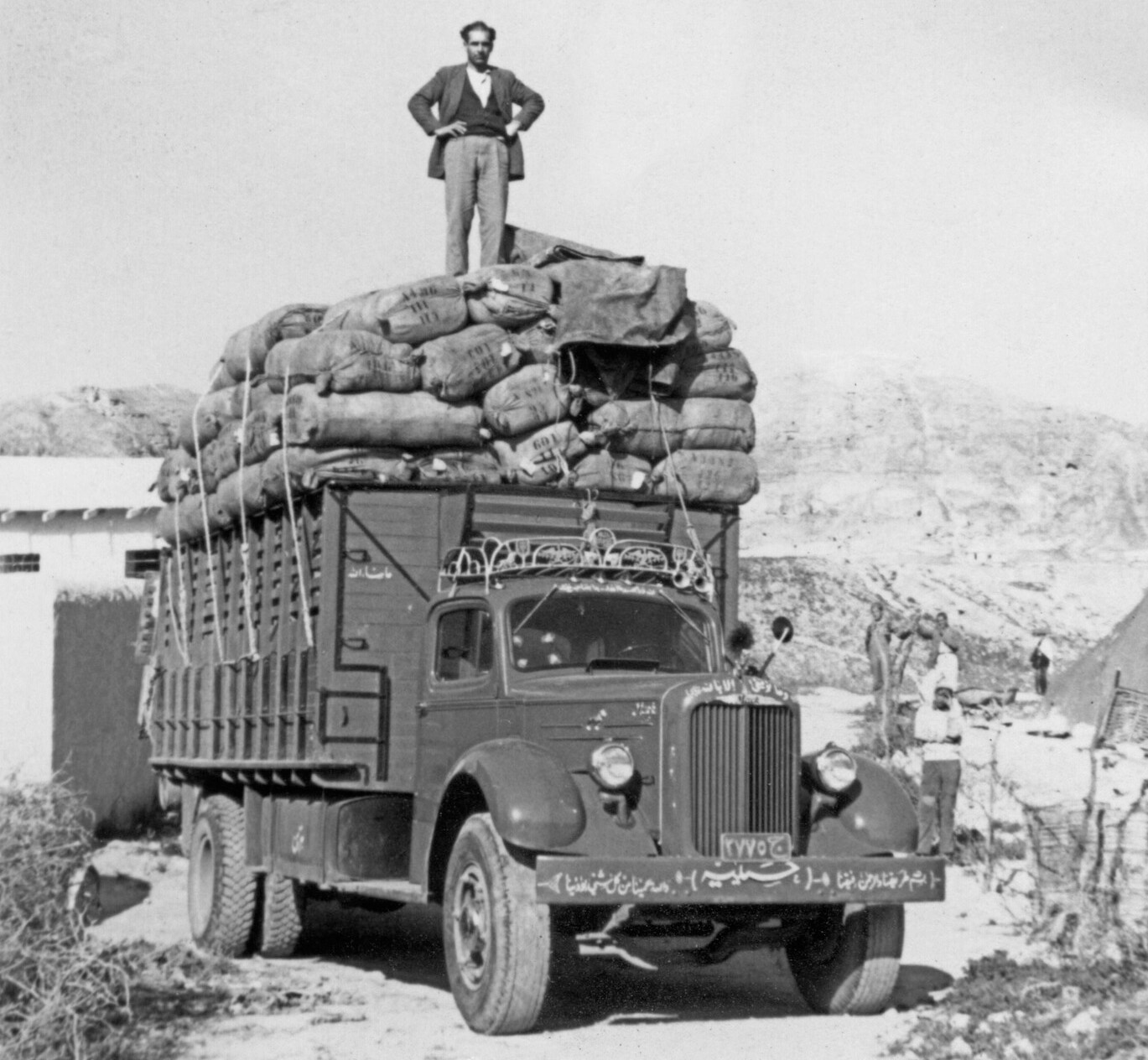
An MCC worker at the time, Waldemar Schroeder, likened the refugees to the man in the parable of the Good Samaritan who fell among thieves: “The Christian church and the world should know about the injustice of the situation so immediate relief could be brought in food and clothing.”
Scrolling through these images and the words describing the suffering some 75 years ago, Sarah Funkhouser and her husband Seth Malone, who serve as MCC representatives for Jordan, Palestine and Israel today, are struck by the parallel to families’ suffering in Gaza now.
And it’s not just Gaza. “So many of the historical things highlighted here are still relevant today. Ein el-Sultan remains a refugee camp. Displacement and deaths from the conflict that sparked MCC to come to this region remain a threat to families today. MCC continues to strive to give people more and more ways to develop their livelihoods and to thrive, yet without addressing the underlying causes of displacement and dispossession, we see history repeat itself, ” Funkhouser stressed.
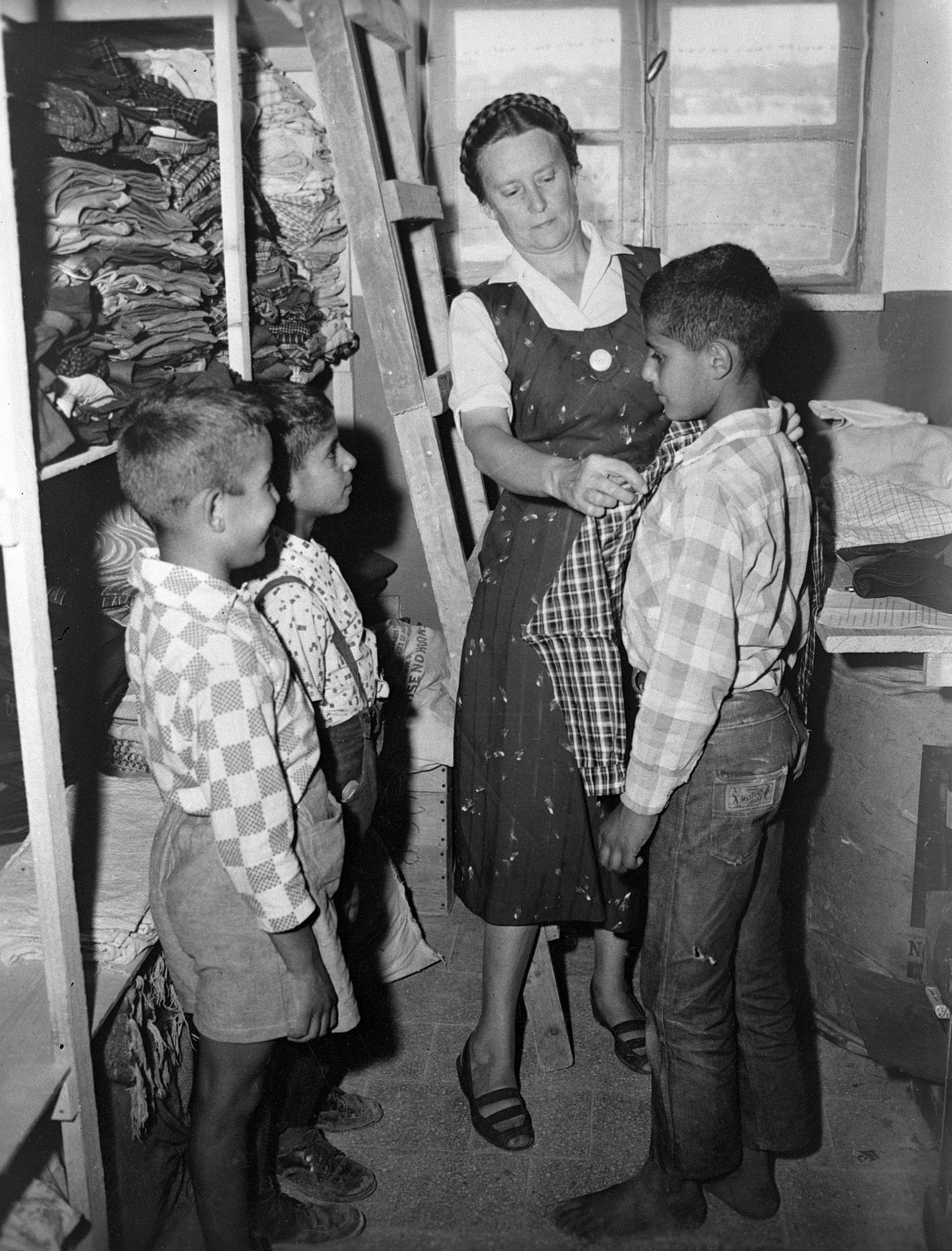
In response to the influx of refugees, from 1950 to 1966, MCC distributed 2,390,971 pounds of bedding, shoes and clothing; 487,979 pounds of food and 43,286 pounds of soap and medical supplies throughout the West Bank and East Bank of the Jordan river. The West Bank was under the control of Jordan from 1948 to 1967 and has been under Israeli military occupation since then. At its peak, the Jericho center distributed clothing to 65,000 refugees per year.
While relief efforts would continue for more than a decade, volunteers knew early on that much more was needed.
“Just feeding and clothing these people,” lamented distribution coordinator Irvin Kennell in 1951, “is like giving aspirin to someone who has appendicitis.”
"Just feeding and clothing these people is like giving aspirin to someone who has appendicitis."
Irvin Kennell
distribution coordinator
Shoemaking, sewing and more
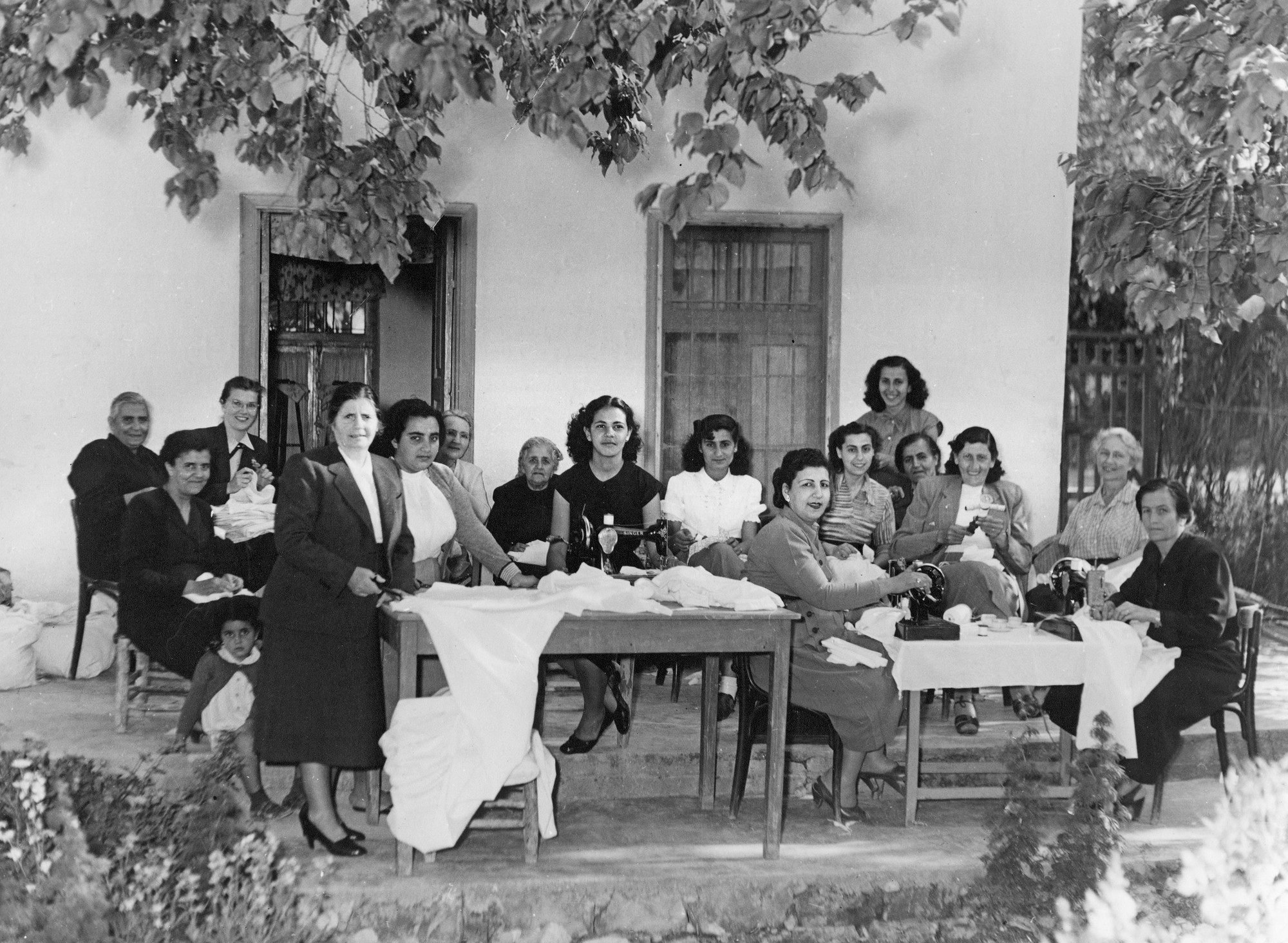
Vocational training and instruction in practical skills were steps to put Palestinian refugees on firmer economic footing.
Indeed, MCC’s pioneer program in Jericho, opened in November 1950, was a shoemaking school housed under a tent donated by the United Nations (UN). Soon, cobbling courses were joined by vocational training in woodworking and basic sewing, then efforts to offer women the opportunity to embroider traditional Palestinian patterns on material donated by MCC.
In fall 1951, MCC organized a Christian sewing circle patterned after Mennonite sewing circles in Canada and the U.S. The circle brought together women from Jericho and the refugee camps to make dresses and pants for children in Jericho public schools from material donated by MCC.
Moved by the effects that war-induced poverty was having on women and children, MCC began working with expectant mothers. As MCC worker Geraldine Ebersole said, "Mothers living without proper food for nearly four years are in no condition to bring new babies into the world, and there is not adequate food for the babies. The effect on the next generation will be tragic. You have to see it to believe it.” This, notes Funkhouser, “remains the reality today. The quote from Geraldine could very easily be about mothers in Gaza today.”
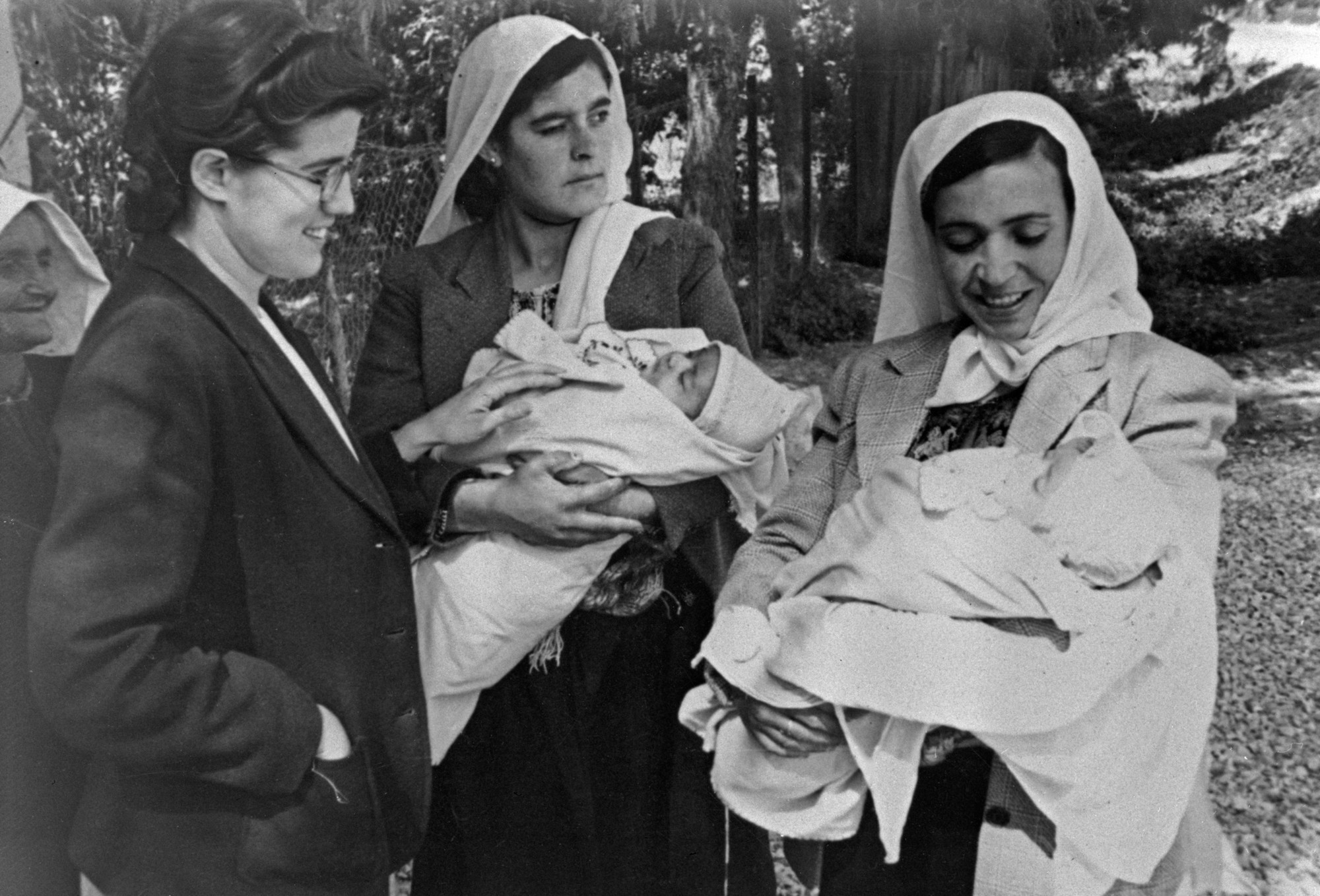
"Mothers living without proper food for nearly four years are in no condition to bring new babies into the world, and there is not adequate food for the babies. The effect on the next generation will be tragic. You have to see it to believe it."
Geraldine Ebersole
MCC worker
In 1951 MCC began a class for expectant mothers in Jericho that soon grew into a layette program providing a set of clothing and items like linens for infants. Women in their fourth month of pregnancy were given the opportunity to come three times a week to make clothes for their babies from material supplied by MCC. After the women completed their work, they were given a ready-made bundle of clothing and other items in addition to the clothes they had made themselves.
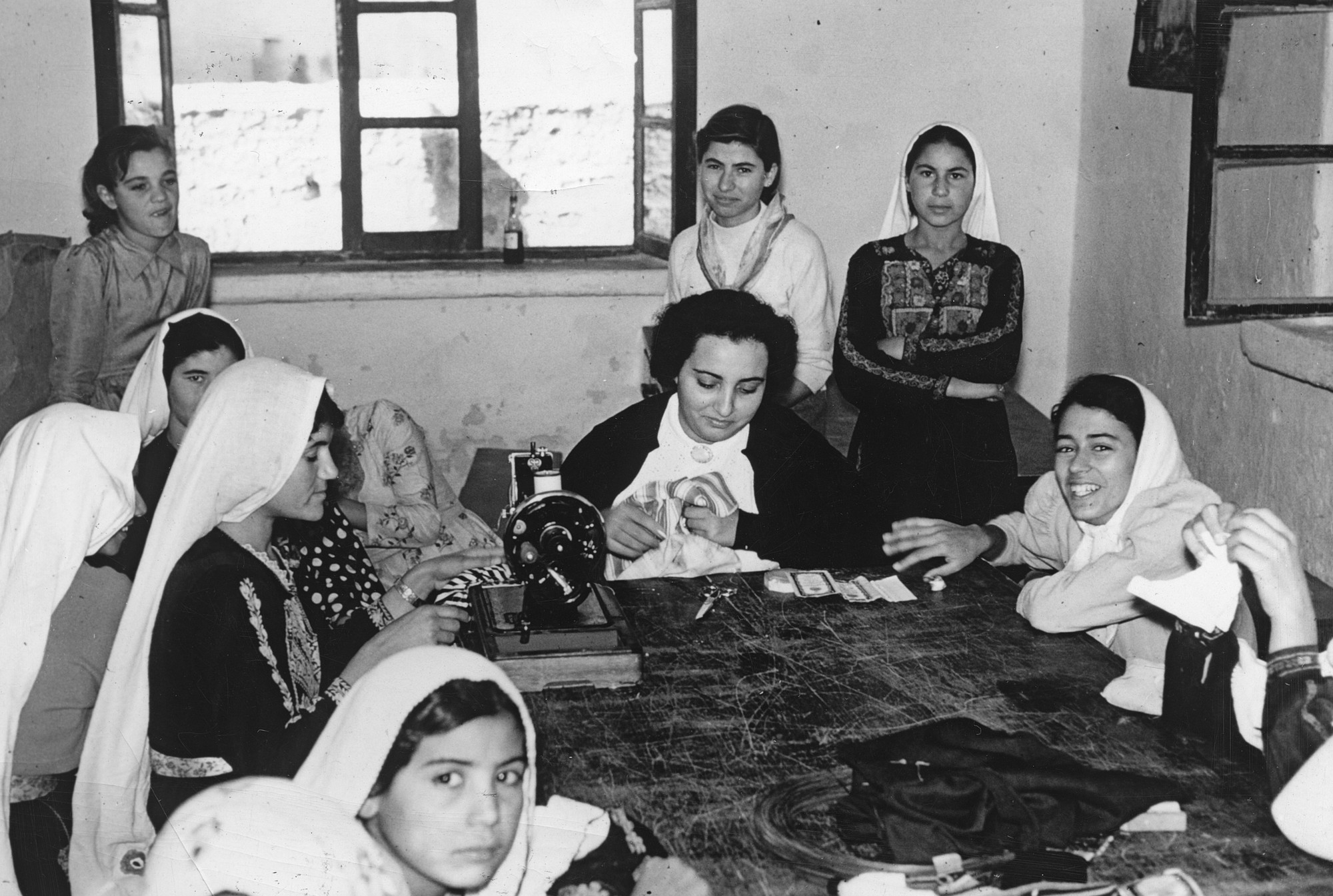
The Palestinian needlework program continued to grow and thrive. At its height in the 1960s, more than 1,000 women from the Jericho and Hebron areas were involved.
Throughout the 1950s, Sophie Farran, who had fled to Jericho from Jerusalem in 1948 and was hired by MCC, reached out to Palestinian refugees in Jericho and surrounding villages, inviting women to do embroidery work that could be sold abroad.
"The women were eager to work. This was the only way they could earn money to support their families."
Sophie Farran
"The women were eager to work. This was the only way they could earn money to support their families,” she recalled. Her home in Jericho became a gathering place for women to do MCC-sponsored embroidery.
But in June 1967, war broke out between Israel and Egypt, Jordan and Syria, forcing many already displaced Palestinians to flee again.

With the war approaching Jericho, and the home where she stored many nearly finished pieces ready for sale in Canada or the U.S., Farran passed out needlework to women in her neighborhood for finishing and safekeeping. Once the roads reopened, even those who had fled sent needlework back with instructions to give it to Farran in Jericho.
During Farran’s first visit of several to refugee camps in Jordan later that year, she reported, “I found one of my needlework women teaching sewing.” (Read more about the needlework program, which was transferred to the women of Surif village in 1979 and continues to operate as a self-sustaining Palestinian cooperative.)
From kindergartens to Bible college

With the fighting in 1967, the refugee camps of Jericho which had been MCC’s primary involvement for more than a decade were left nearly empty after residents fled east, across the Jordan River.
MCC followed, providing emergency assistance in six new UN-administered camps in Jordan. MCC soon opened and supported kindergartens and women’s centers in the camps.
From the first classes in shoemaking in Jericho in 1951, MCC has supported educational initiatives for Palestinians.
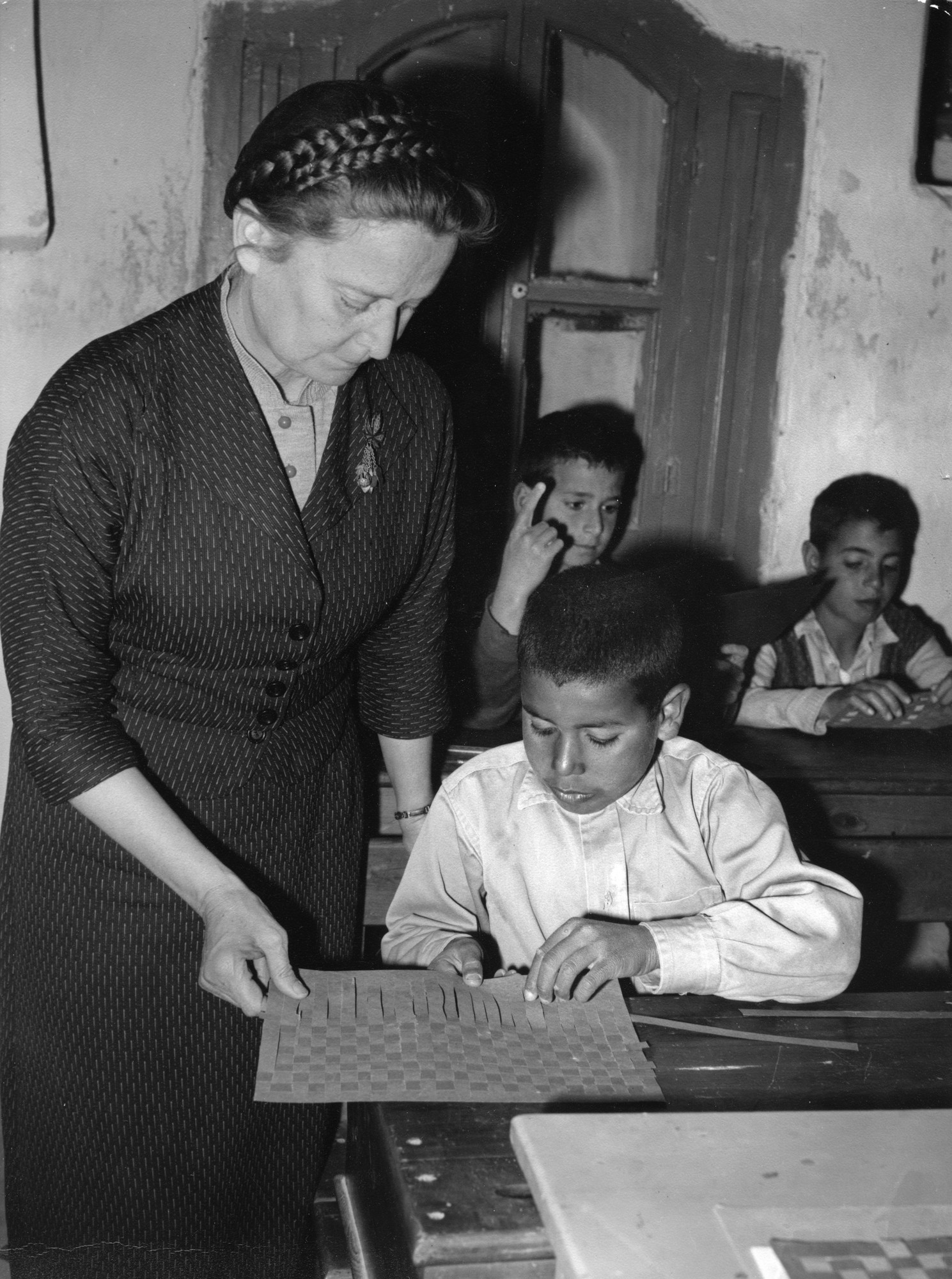
In its early years in the region, “MCC was also known in the Palestinian community for its support of Palestinian Christian schools serving both Christian and Muslim students,” writes Sonia K. Weaver in the book What is Palestine-Israel? Answers to Common Questions.
That included founding an orphanage and school in Hebron, run for years by twins Ida and Ada Stoltzfus, and, later, the establishment of the Mennonite Preparatory School in Beit Jala, a village south of Jerusalem.
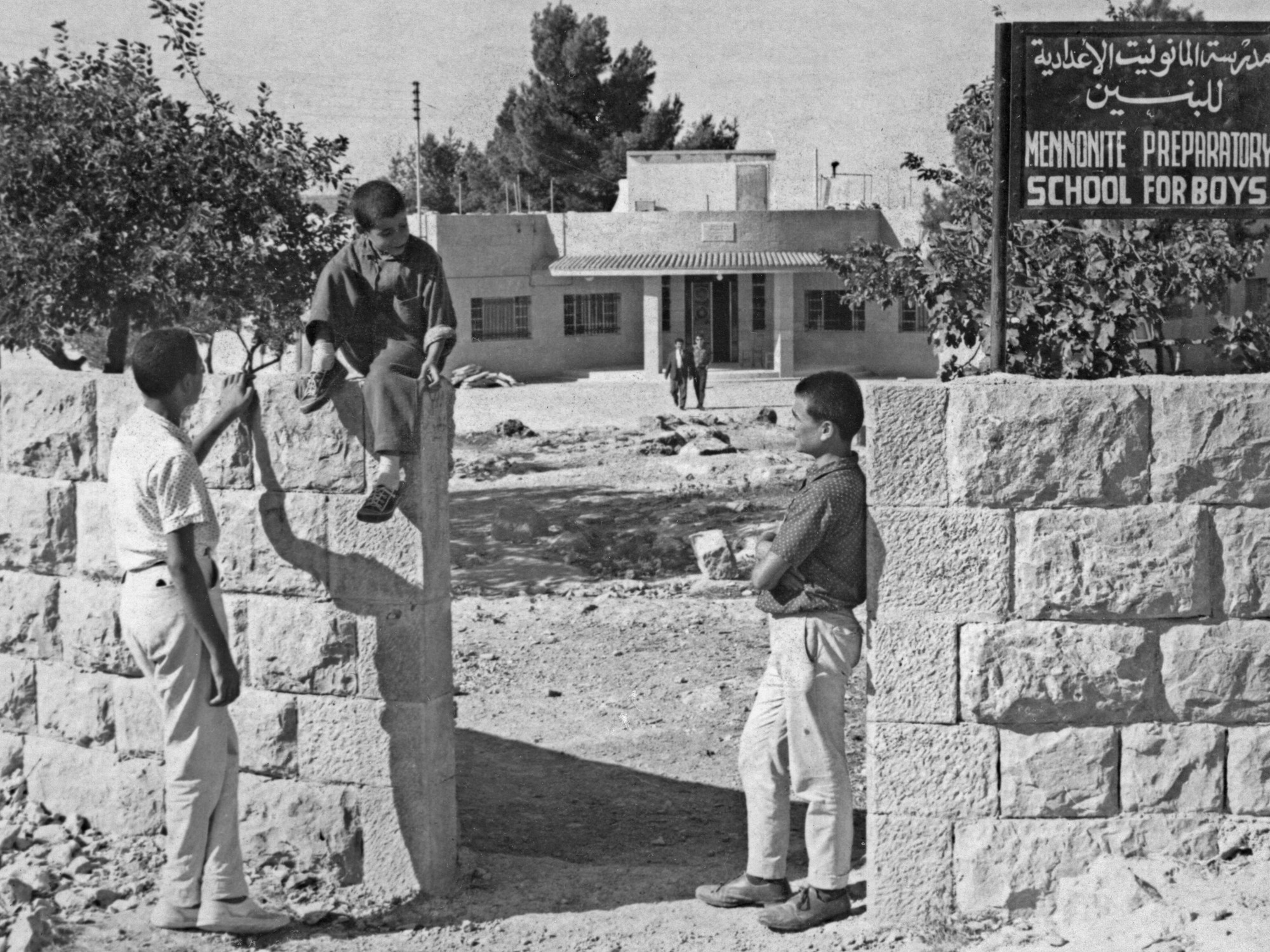
For the next decade, a steady stream of MCC workers would serve in the Mennonite school in Beit Jala, and, as they did, they came face to the face with the reality of the Israeli occupation.
In the early 1970s, when protests against the occupation swept through schools in the West Bank, students and staff at the Mennonite school experienced beatings, detentions and arrests at the hands of military authorities, and one teacher was murdered in prison.
“The situation in the West Bank today is much the same if not worse, especially with the war on Gaza. Communities around the West Bank are frequently threatened with expulsions from their lands and nighttime raids on their homes, with many, including children, arrested and taken to prison. After over 55 years, the Israeli military occupation is not only deeply entrenched but even more brutal,” says Seth Malone.
Increasingly aware of the human rights abuses which came with the Israeli occupation of the West Bank and the Gaza Strip, MCC looked for ways to respond, both by lodging concerns and complaints with authorities in the region and by sharing experiences with churches in the U.S. and Canada and with U.S. and Canadian governments. MCC also began to host study tours for Mennonites from all walks of life to come visit and hear from both Palestinians and Israelis about the realities of the occupation.
The experience of learning tours and bearing witness has continued through the years with efforts to educate Christians in the U.S. and Canada, and to provide first-hand accounts from MCC partners and workers to U.S. and Canadian governments. Read a reflection by Saulo Padilla, migration education coordinator for MCC U.S. National Peace & Justice Ministries, on how the complexity of stories he heard from Palestinians and Israelis on a 2017 tour and what he learned of their shared humanity that shaped his outlook.
In 1976, MCC transferred administrative responsibility for the school to a local Palestinian Christian organization, the Arab Charitable Society, a move that brought with it a name change to the "Hope Secondary School." The Hope School continues to thrive today.
In the late 1970s, MCC worker Bishara Awad, in collaboration with other Palestinian Christian leaders, established Bethlehem Bible College, and MCC provided years of funding and personnel to help it grow. For more than four decades, Bethlehem Bible College has offered biblical and theological training for Palestinian Christians through the lens of Jesus' way of love and nonviolence.
Along with educational efforts, in the 1970s MCC established an agricultural unit, focusing on rural work to develop land and water resources, increase food production and increase the income and self-reliance of farming communities.
Expanding efforts and partnerships
Those activities reflect the aims of MCC’s agricultural efforts in regions across the globe, but the program faced challenges unique to the Israeli occupation. These ranged from Israeli policies of confiscating Palestinian land for settlements to the military government’s refusal to grant Palestinian farmers permits for drilling new wells to barriers for Palestinians exporting produce from the West Bank or Gaza Strip.
Since arable land was less subject to confiscation than nonarable land, MCC assisted farmers in preparing their land for cultivation and distributed thousands of the seedlings to farm families in the Ramallah, Bethlehem and Hebron districts of the West Bank starting in 1976.
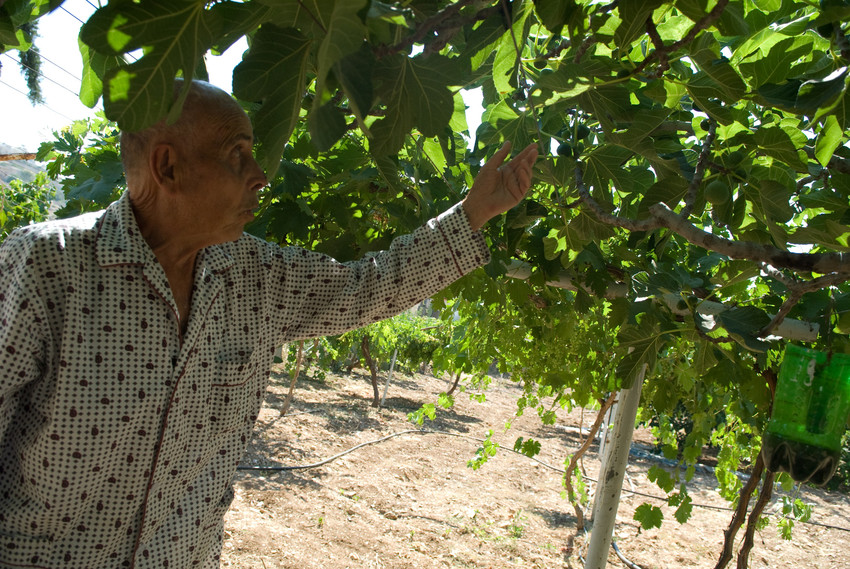
This work continued into the 1980s and 1990s as MCC cultivated partnerships with local organizations. During this time, MCC provided seed funding to what would later become a long-time partner named the Applied Research Institute - Jerusalem (ARIJ), which focuses on sustainable agricultural development in the West Bank.
After 40 years, MCC and ARIJ still partner together to provide rural communities in the West Bank the tools and resources to build their livelihoods and remain on their lands in the face of Israeli restrictions on water and land confiscations.
While MCC increased its focus on local partnerships and development, the need for relief continued. Nowhere is that more evident than in Gaza.
Into the Gaza Strip
The 1990s brought a new focus on the Gaza Strip for MCC.
MCC workers Alain Epp Weaver and Sonia Weaver moved to Gaza in 1995 to explore possible MCC partnerships. “It was a time of optimism, with the Oslo peace accords between Israel and the Palestine Liberation Organization (PLO) having led to the establishment of the Palestinian Authority in parts of the occupied Palestinian territories, including parts of the Gaza Strip,” he wrote. But by 1999, when they returned for another year, drastically fewer Palestinians were allowed out of Gaza, and Israel’s economic blockade on Gaza started to take shape.
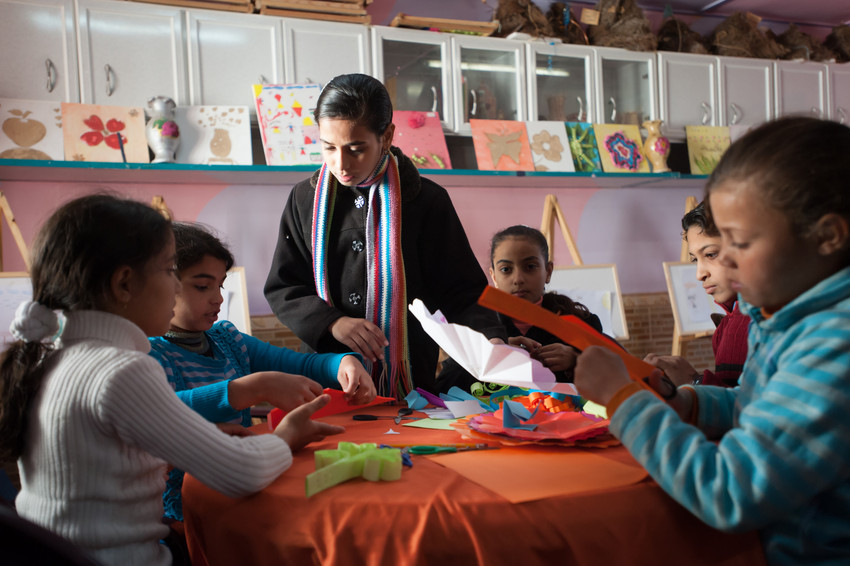
As the economic outlook became increasingly more dire, MCC supported Palestinian organizations like Culture and Free Thought Association in Khan Younis and the Near East Council of Churches in Gaza City.
For years through summer camps and its Child-to-Child program, the Shoroq wa-Amal, or Sunshine and Hope, Center of MCC partner Culture and Free Thought Association has provided a nurturing space for children in Gaza's Khan Younis refugee camp, giving children leadership training and healthy outlets for self-expression.
With the outbreak of the current violence, CFTA converted their centers into spaces for people to take refuge. Now, after months without a ceasefire, CFTA’s centers have been damaged or destroyed and some of its staff members have been killed.
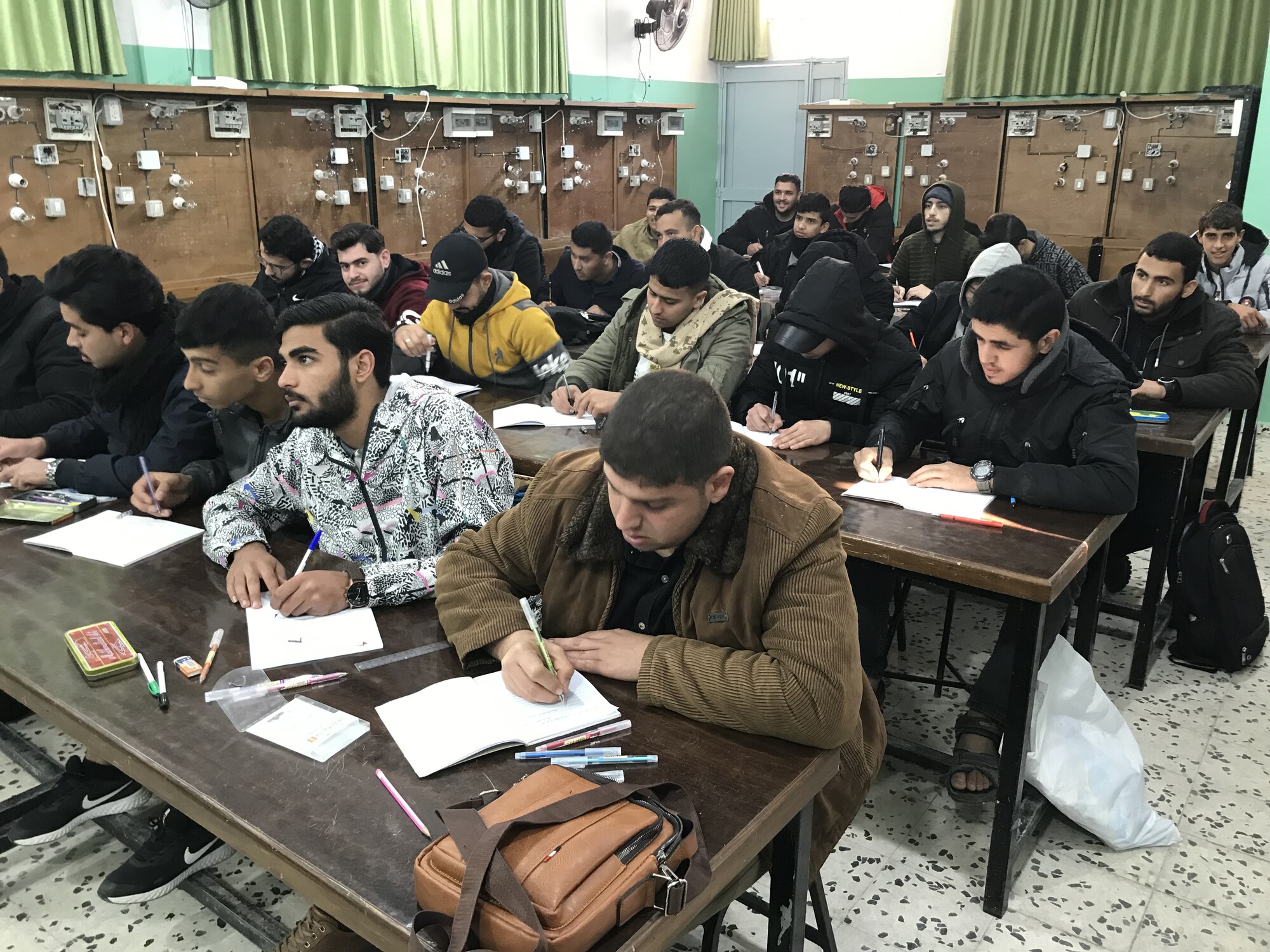
Another MCC partner, Near East Council of Churches (NECC), has offered young people vocational training and the opportunity to learn a trade. Conducting programs in areas from woodworking and sewing to electrical repair, NECC has given students the skills needed to earn an income, a critical need for years in the Gaza Strip where unemployment and economic turmoil have soared due to the Israeli blockade, which severely limits the movement of goods and people into and out of Gaza.
Taking part in the training program was one way to significantly improve economic prospects. Of 29 positions advertised in 2022 by Gaza’s main electricity company, 22 were filled by NECC training course graduates. Now, of course, no classes can happen. Indeed, NECC’s training building in North Gaza was destroyed by Israeli bombing in October 2023.
Another one of MCC’s key partners in Gaza is the al-Najd Developmental Forum. Since 2008, MCC has partnered with Al-Najd to address both relief and development in Gaza. For many years, MCC funded a food security program that focused on breeding rabbits. While it was successful to some extent in bringing stable food and income to families, many of the rabbits would die of shock or would be killed because of successive Israeli bombing campaigns on Gaza.
In response to the bombings, MCC would also partner with al-Najd on emergency relief distributions and on repairing damaged homes. After major Israeli military attacks in 2014 and 2021, al-Najd worked to rehabilitate dozens of homes in the northern area of Gaza, which helped provide shelter to vulnerable families, particularly during the winter months. Many if not all of these homes have since been destroyed in the current war.
Throughout MCC’s time in Gaza, long-term efforts in development, whether in education, food security, or leadership, have given way to emergency relief. Instead of looking ahead to how families can thrive in the future, responses are focused on what is needed to survive now.
Among many of its emergency responses since the outbreak of the war, MCC has partnered with al-Najd to deliver food into Gaza to distribute to vulnerable families facing starvation. Read more about this large-scale food security project.
Peacebuilding and the ongoing Nakba
Alongside its work in relief and development, the MCC Palestine and Israel program has prioritized peacebuilding. As that peacebuilding work has grown, MCC has partnered with Palestinian and Israeli organizations committed to a better future for all who live on the land.
One of MCC’s Israeli partners named Zochrot works to educate Israeli society about the Nakba, both historical and ongoing. It includes tours to places such as Canada Park, which was built on the land of Palestinian villages in the West Bank demolished by Israeli forces in the 1967 war. The work of Zochrot is important in insisting that a peace rooted in justice is the only way to build a future of dignity and safety for all who live on the land. See a December 2023 video message on the crisis in Gaza from current Zochrot director Rachel Beitarie.
With Israel’s endless bombing campaign on Gaza since October 2023, Palestinians have been forced to flee with no assurances of safety or return. MCC partners have faced death and displacement over and over again, all the while working to serve the needs of the most vulnerable. Of the 2.2 million Palestinians in Gaza, 1.7 million have been forcibly displaced. Now, with the Israeli military invasion of the southern city of Rafah, hundreds of thousands of people are fleeing for their lives once again. Organizations like Zochrot remind us that the events of today are a continuation of a long history starting with the Nakba.
As we reflect on this history, and MCC’s role in it, we remain committed to the vision of communities worldwide in right relationship with God, one another and creation. With current violence, now more than ever, MCC envisions and will continue to work for a future of safety, dignity and peace for all who live on the land.
What you can do
Wondering what you can do in the face of repeated crises?
Palestinian Christians are asking that Christians in the U.S. and Canada remember the people of Gaza and speak out on behalf of their suffering.
In Canada, join us in asking the Canadian government to press for increased humanitarian aid and unimpeded access for humanitarian aid and uphold recent Canadian commitments to cancel weapons sales to Israel.
MCC partners in Gaza are continuing to respond to the urgent needs around them in the midst of danger, displacement and famine. Give now to help to meet urgent needs.
As people of faith, we know that, while we are called to care and to act, it is God who holds the needs of the world and the future, not us. Please pray for Palestinians and for Israelis. Pray for peace, for safety and for hope for families who are living without either of those.
Read a reflection by Alain Epp Weaver: Gaza, catastrophe and 75 years of Mennonite witness in Palestine and Israel
Learn more about MCC’s response in Gaza.
Explore frequently asked questions about MCC and Palestine and Israel
Text accompanying these photos is drawn primarily from the book Salt & Sign: Mennonite Central Committee in Palestine, 1949-1999 by Alain Epp Weaver and Sonia K. Weaver. Alain Epp Weaver has written extensively about Palestine and Israel, including the recent book Inhabiting the Land: Thinking Theologically about the Palestinian-Israeli Conflict.
Give to MCC's Gaza crisis response
Every donation makes a difference.

